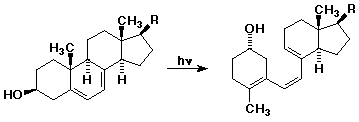![]()
![]()
Chapter 26 Workshop Problems
Lipids
1. Draw a good conformational structure for cortisol, shown below:

2. Dehydration of fats at high temperature (e.g., frying bacon) leads to acrolein (propenal) as a volatile decomposition product. Propose a mechanism.
3. Write a complete IUPAC name for the monoglyceride that would be formed between glycerol and oleic acid. Indicate stereochemistry and all of the various possible isomers.
4. Glycerol is often used as a comonomer with ethylene glycol in a step reaction polymerization with terephthalic acid. Show the repeat unit of the polymer (without glycerol) and explain what differences in structure and properties would be expected by inclusion of glycerol.
5. One of the key reactions in the biosynthesis of vitamin D (the sunshine vitamin) involves the photochemical ring-opening of ergosterol as shown below. Number the carbons and indicate the electron flow that leads to the reaction. Describe the transition state and the observed stereochemistry.

6. Cobra venom contains a phospholipase that hydrolyzes the
fatty acid ester on C-2 of phospholipids. Write the structure
of a typical lecithin before and after this hydrolysis.
The effect of the hydrolysis is to destabilize the membrane structure.
In general, phospholipids (with two fatty acid "tails")
form stable bilayers, while simple detergents (with a single fatty
acid "tail") form micelles. Based on the structural
differences, explain the different behaviors.